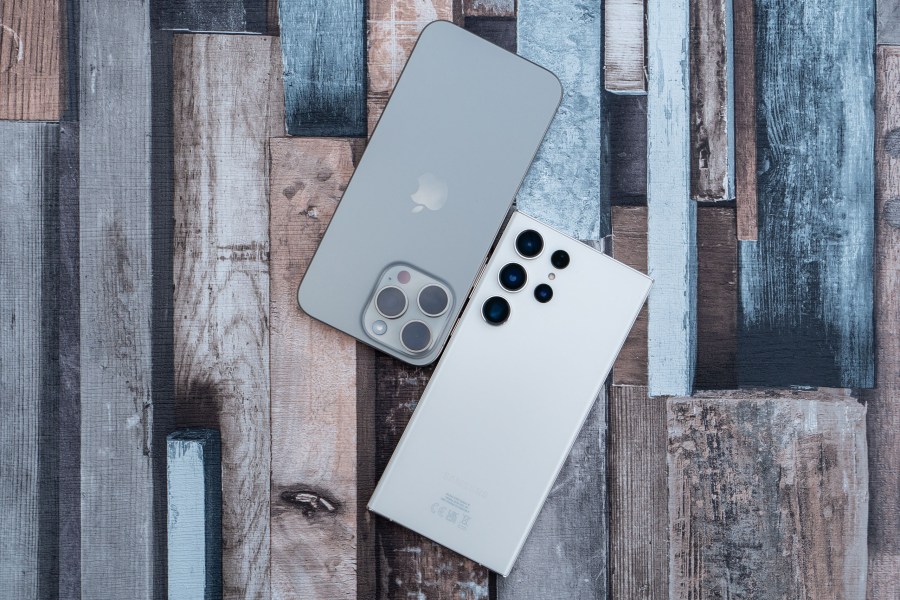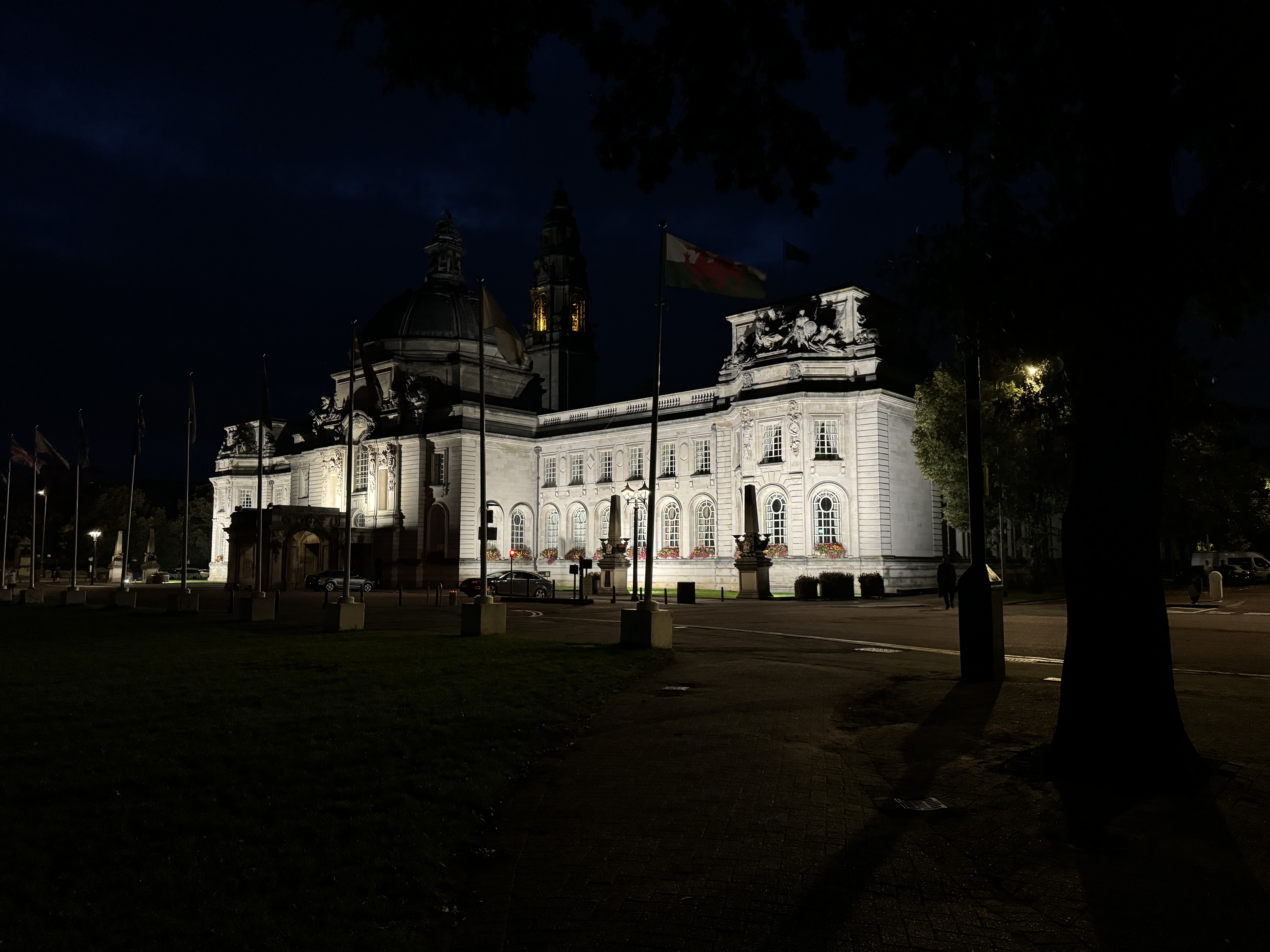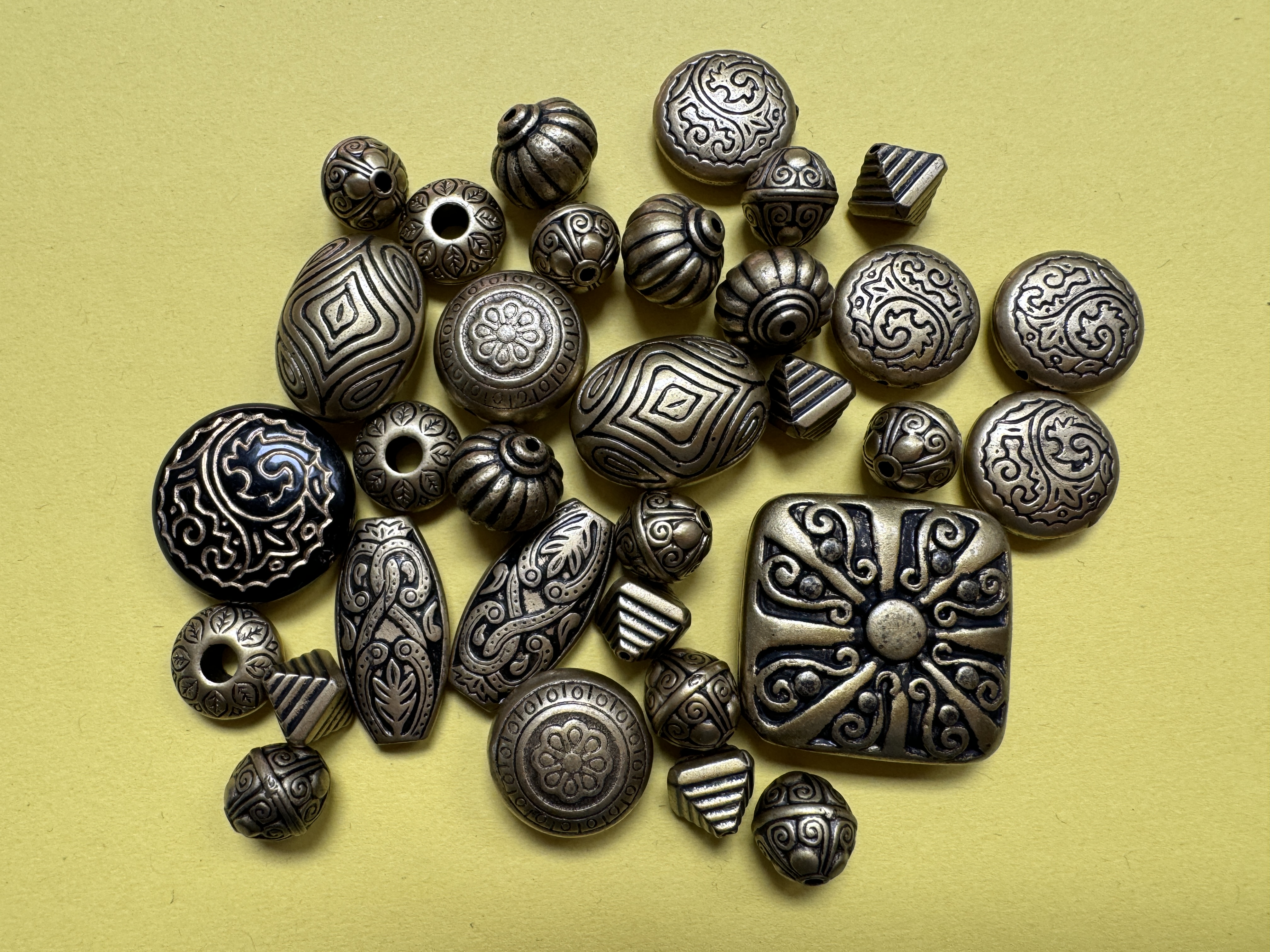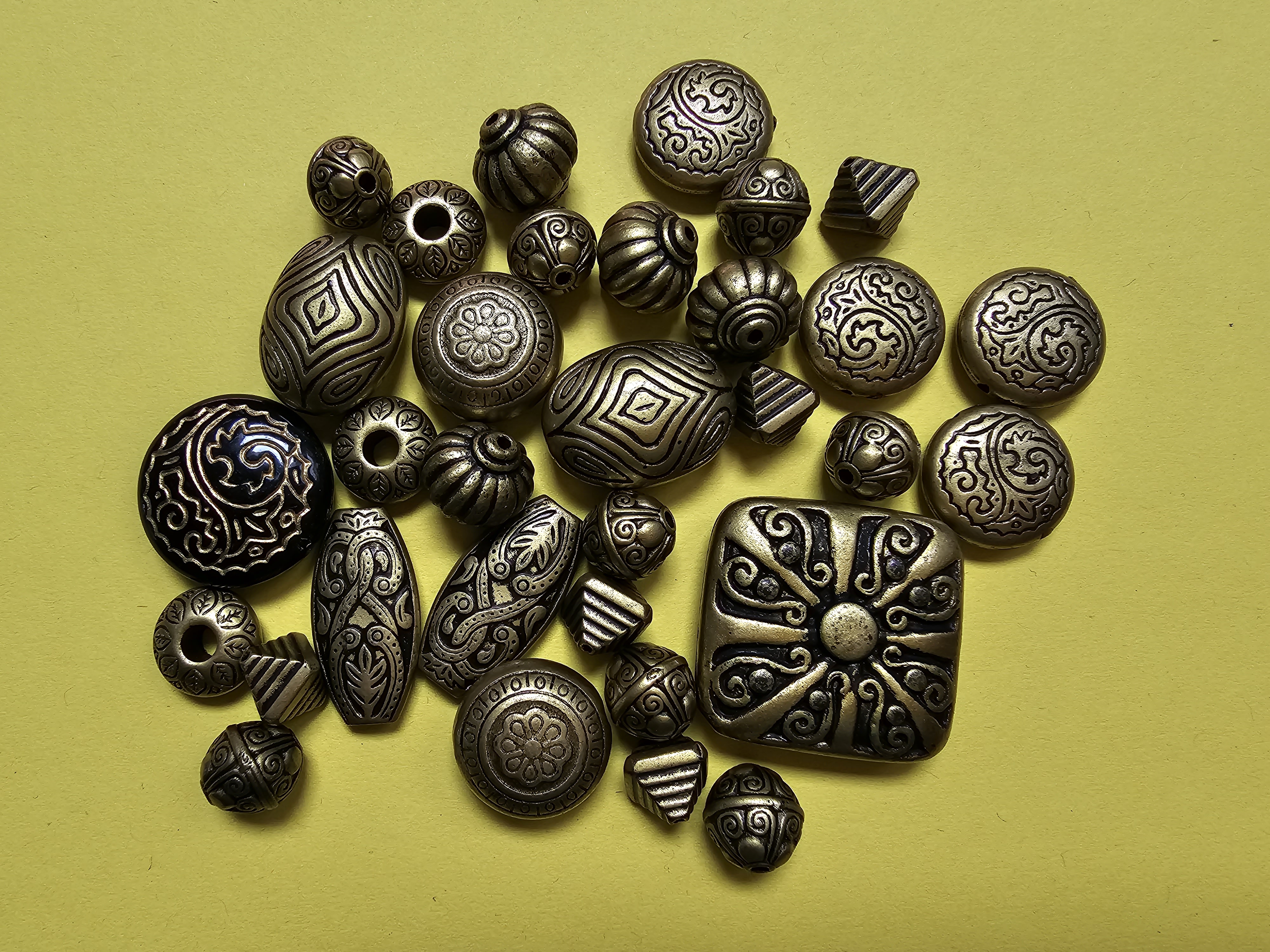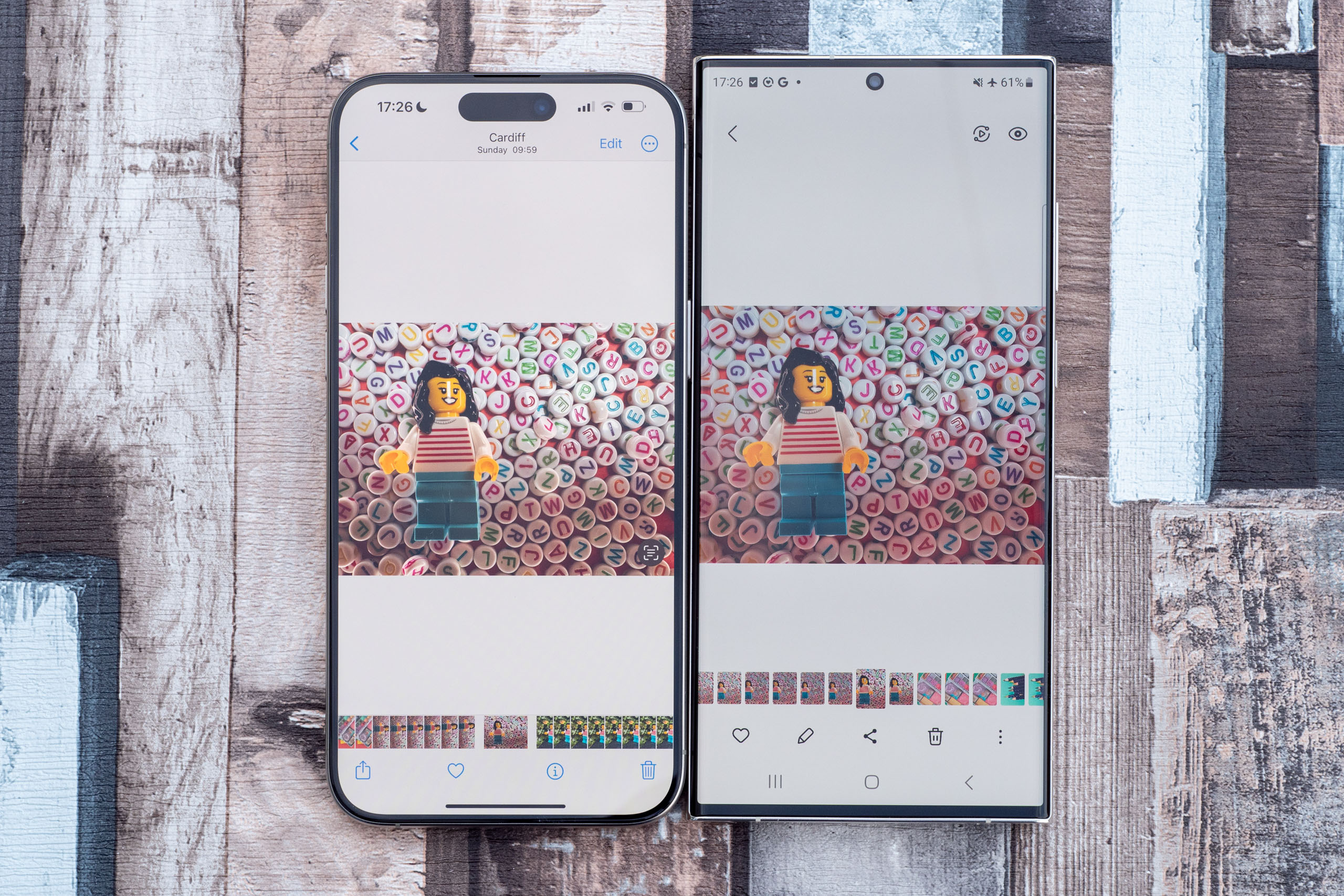The two biggest names in smartphones remain as Apple and Samsung, despite lots of competition from those found on our best smartphones for photographers list.
With the launch of the new flagship iPhone 15 Pro series, which comprises the iPhone 15 Pro and the larger iPhone 15 Pro Max, it’s time to start looking at how they stack up against the big Android competitor – in this case the Samsung Galaxy S23 Ultra.
Having reviewed both independently and also used them at the same time to capture photographs and videos, we can see how they fare when going against each other head to head.
iPhone 15 Pro Max vs Samsung Galaxy S23 Ultra: Camera specs
In terms of specifications, both of these flagship models are reasonably similar to their predecessors, the iPhone 14 Pro Max and the Samsung Galaxy S22 Ultra, so if you’ve been using either one of those, you should be quite familiar with what you get here.
For the iPhone 15 Pro Max we have a triple-lens setup, with a standard (1x, 24mm equivalent, f/1.78), ultrawide (0.5x, 13mm equivalent, f/2.2) and new for this model is a 5x (120mm equivalent, f/2.8) lens – previously the iPhone 14 Pro Max had a 3x lens. There are also other “lenses” in between, including a 1.2x, 1.5x and 2x, which use the middle part of the main sensor to main high resolution. The three sensors are 48MP (1x), 12MP (0.5x) and 12MP (5x).
Meanwhile, the Samsung Galaxy S23 Ultra goes one step further boasting a quadruple-lens setup. We’re still yet to see this from other models on the market, and it gives you a nice bit of extra reach. There’s a standard (1x, 24mm equivalent, f/1.7), ultrawide (0.6x, 13mm equivalent, f/2.2), and two telephotos – 3x (70mm equivalent, f/2.4) and 10x (230mm, f/4.9). The main sensor is a whopping 200MP, up from the 100MP of the S22 Ultra, while the others are 12MP (0.6x), 12MP (3x) and 10MP (10x).
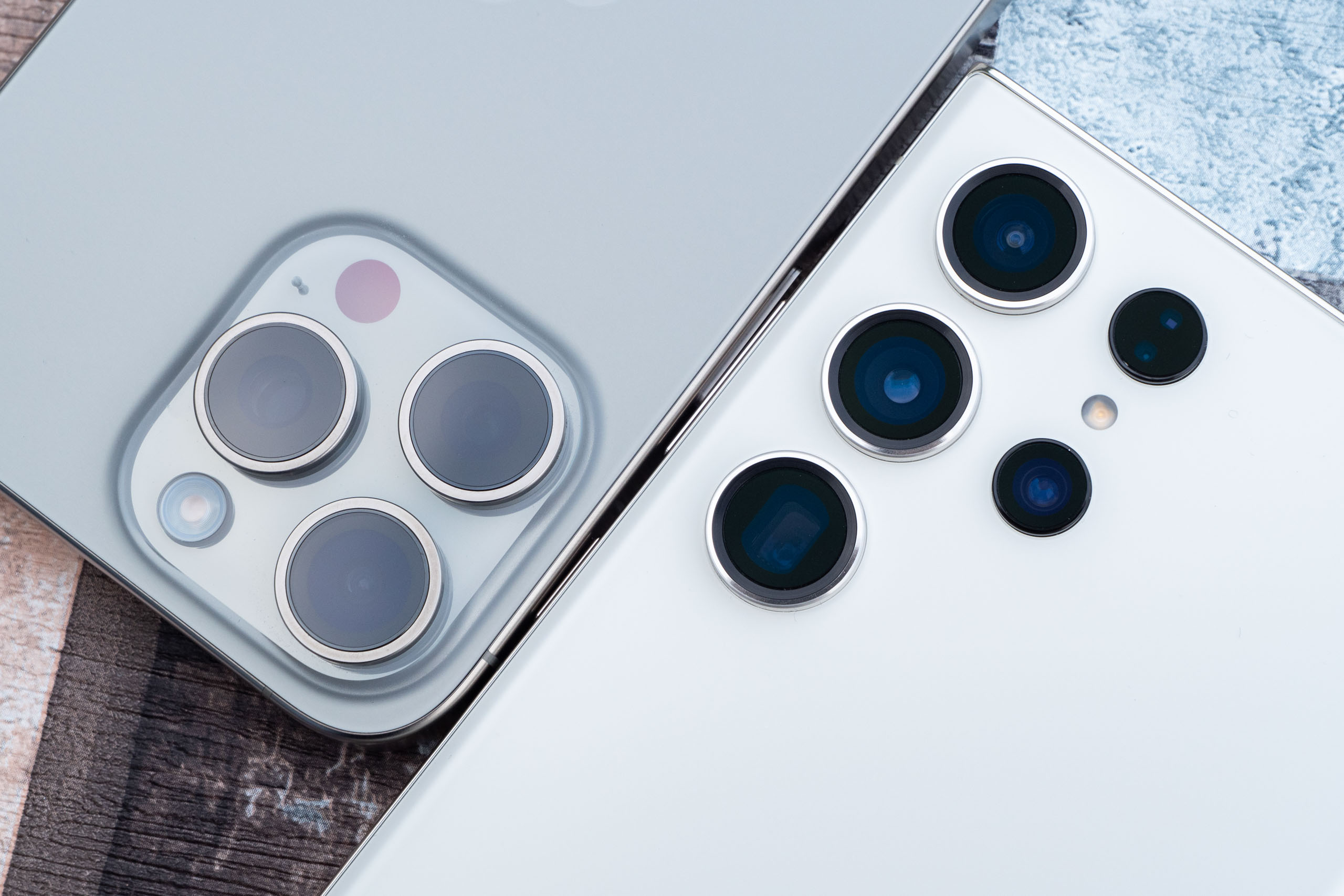
There are also digital zooms available for both models, with the S23 Ultra having the headline friendly “100x” space zoom. The iPhone has a more staid – but probably more sensible – 25x digital zoom.
With the S23 Ultra you get up to 8K (24/30fps) video recording, with 4K (60/30fps) and Full HD (60/30fps) options also available. The iPhone 15 Pro Max tops out at 4K (60/30/24fps), with Full HD (60/30fps) options too.
Both the phones have a 12MP selfie camera, both with autofocus.
Looking purely at camera specs alone, the S23 Ultra is the clear winner here – with the extra lens and the better video capability. But in real-world shooting, things may be a little different.
iPhone 15 Pro Max vs Samsung Galaxy S23 Ultra: Camera apps and shooting modes
The native camera app of both models is likely what you’ll use to take most of your shots – although plenty of third party app options are available for both Android and iOS.
Something that can be both considered a positive and negative for the iPhone is its simplicity. Some like the fact that it’s fairly straightforward and uncluttered, while others crave more control. That said, the iPhone has added more functionality to the native camera app over the years, so there’s quite a few things you can do directly from it – all while keeping that fairly “simple” interface and ethos.
Most of the time, you’ll use “Photo” mode, where things like portraits, night and macro shooting are automatically detected. You can shoot in raw format directly from this mode, while adjustments can be made to things like Photographic Styles and exposure compensation. Other than a portrait mode, there’s little else in the way of photo shooting modes, but for video, there’s not only a standard video mode, but there’s also things like “Cinematic” for creating shallow depth of field, Slo-Mo and Time-Lapse.
By contrast, you might argue that the S23 Ultra gives you too much choice – a good thing for photographers perhaps. As well as a standard photo mode where things like night and macro are automatically recognised, there’s also a Portrait mode, alongside things like Food and Panorama. For greater control, there’s two different types of manual mode – Pro and ExpertRAW. You can adjust things like shutter speed, white balance and more with these so they’re great for those who crave that. It’s only in these advanced modes that you can shoot raw format.
As for video, there’s again a standard video shooting mode, as well as a portrait video mode, hyperlapse, slow motion and more advanced options such as pro video and “Director’s View”.
Again, it’s the Samsung which probably comes out as the winner here – depending on your point of view. We’d like to see raw shooting added to the Samsung’s general photo mode for maximum flexibility, but otherwise, for those who want comprehensive shooting options, it has to be the Android phone that you pick.
iPhone 15 Pro Max vs Samsung Galaxy S23 Ultra: General image quality
Both of these models take excellent photos in lots of different conditions, but of course particularly in good light.
There’s plenty of detail recorded by both, with the 200MP sensor of the S23 Ultra doing a great job to bring out slightly finer details in certain situations. That said, the 48MP sensor of the iPhone 15 Pro Max is more than enough to also produce finely detailed shots, and with the standard output of the iPhone 15 Pro Max now 24MP, you have a bit more scope when cropping.

Colours are good from both, but if you look at both side by side, you can see quite clearly that the Samsung’s are more vibrant, which can look a little unrealistic at times. For those that want a more muted look, you might need to shoot in the Pro modes. Meanwhile, while the iPhone shots are bright, they’re also more realistic and natural.
The colour matching between the lenses on both models is very good, meaning you tend to get the same kind of look no matter which lens you use.
Exposures are well balanced between the two models, with high contrast scenes showing a good blend of highlights and shadows, too.

When a scene contains artificial lighting, Samsung’s are a tiny bit warmer than the iPhone – again producing images which are slightly different from real life. It’s not a big enough difference to be noticeable except when directly comparing two images together – so you’ll likely be pleased with whichever model you go for.
This one is a bit of a tied situation, with both putting in an excellent performance – perhaps if we look a bit closer at specific situations, we might reveal some bigger differences…
iPhone 15 Pro Max vs Samsung Galaxy S23 Ultra: Zoom
Having that extra lens should in theory mean that the Samsung S23 Ultra produces better results than the iPhone 15 Pro Max, which would need to rely on digital zoom to get as close as the Samsung can.
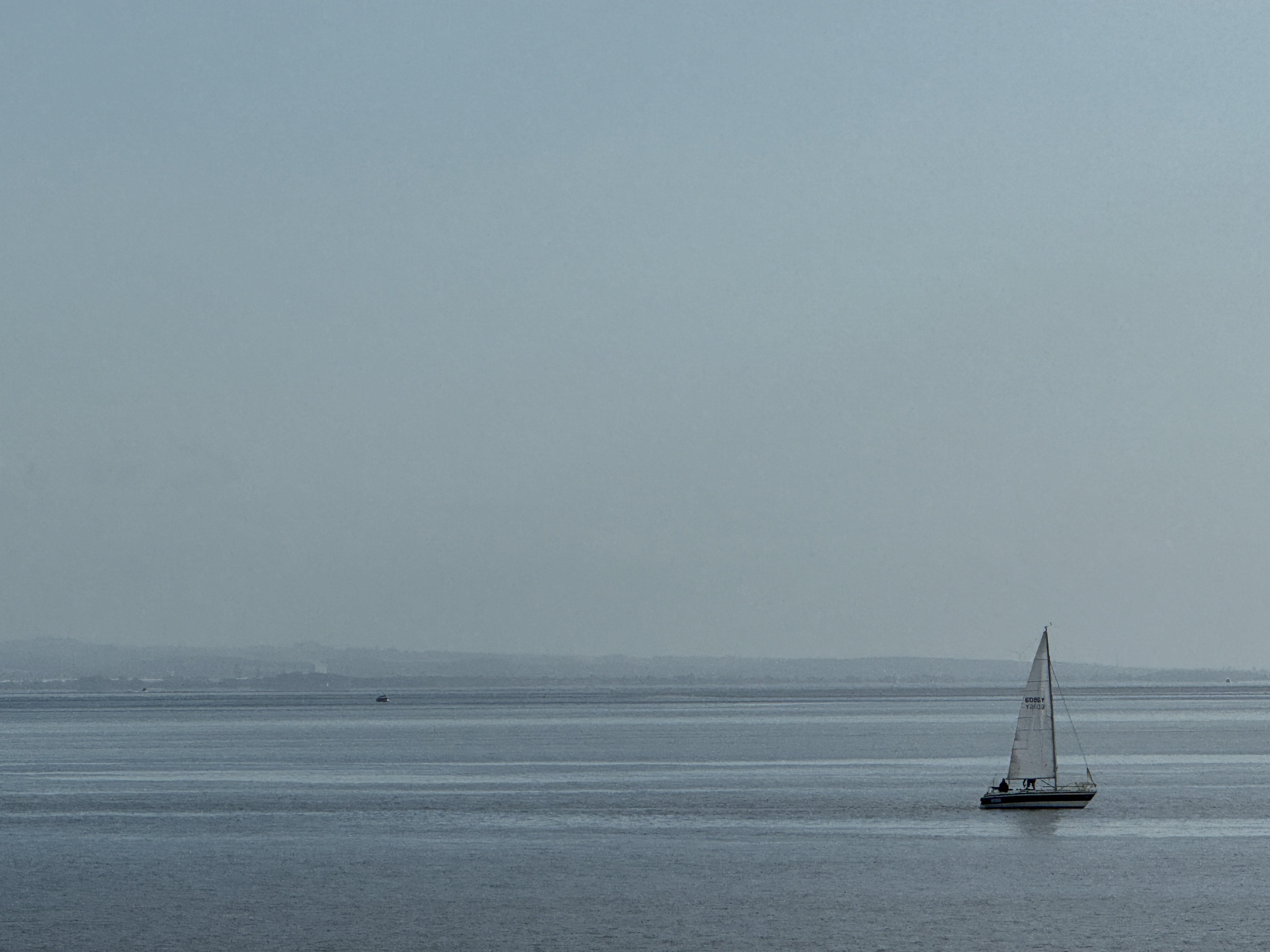

We can see quite clearly that at 10x digital, the iPhone’s image is inferior to the Samsung’s, which is both brighter, more finely detailed and demonstrates better colour rendition. It’s fairly unlikely you’d want to use 10x digital from the iPhone apart from for standard record shots, whereas with the Samsung, you can create far more usable images.
Extended beyond that, the iPhone’s maximum 25x digital zoom is pretty terrible, with the Samsung’s 30x option doing a much better job – albeit still not something you’d likely hang on your wall with pride. The 100x “Space zoom” from the Samsung is definitely best avoided, and is almost certainly included as a marketing gimmick only.
Talking about zoom alone, we have to give this one to the Samsung. How often you want to use long focal lengths is debatable though, so it’s probably not something that will completely sway most users.
iPhone 15 Pro Max vs Samsung Galaxy S23 Ultra: Low light
Both the phones have night modes, with both kicking in automatically should low light be detected. With the Samsung, you can manually select to shoot in Night mode too. In these two images, the iPhone’s night mode did not automatically engage, and with no way to select it yourself, the results are a lot poorer than the Samsung’s, which shows off a much better exposure, with far more highlights in the foreground of the image.
Where the Night mode definitely does activate, the Samsung still puts in a better overall performance, with an overall brighter and better balanced exposure. The iPhone is still very good though, so if you do a lot of low light / after dark shooting, it’s still a good choice.
Here again, the Samsung is the winner, during our tests at least. Both do a very good job, but with the Samsung giving you more control over whether or not it’s activated, plus a better overall exposure in very dark conditions, it just about pips the iPhone.
iPhone 15 Pro Max vs Samsung Galaxy S23 Ultra: Macro
With either of the phones, a macro mode will automatically activate should you get very close to a subject. In doing this, the phone will switch from the main sensor to the ultrawide sensor, thus losing you the ability to shoot in very high resolution mode on either device.
You can switch off macro shooting, but you won’t be able to get as close to the subject – depending on the subject, that may or may not be a problem.
Here, I took a very close-up shot of a set of beads, with both phones automatically switching to macro mode when I was almost touching the subject. Both do an excellent job of producing highly detailed shots, but I have to give the edge to the Samsung – just about – which has just a little more noticeable visible detail, which is exactly what you’ll generally be looking for when it comes to macro work.
The Samsung shot is a bit more vibrant, as we see elsewhere, but the iPhone shot is more realistic.
This shooting situation is a close-run thing between the two models, with both producing great results. The S23 Ultra is just that little bit better though, overall.
iPhone 15 Pro Max vs Samsung Galaxy S23 Ultra: Portrait
A new (and very useful) feature of the iPhone 15 series is automatic portrait detection. This means that if you point it at a person, dog or cat, the phone will record all the relevant detail it needs to produce a shallow depth-of-field effect, which you can add or remove after the fact depending on your preference. That’s great for capturing quick off-the-cuff shots and deciding whether you want a standard or portrait effect later. You can also shoot in a specific Portrait mode if you prefer.
With the Samsung S23 Ultra, you don’t get the benefit of automatic detection, but there is a Portrait mode available.
After you’ve shot your portraits, with either model, you can adjust the focus point and strength of blur in editing too – so you can have quite a lot of fun with either model.


With the iPhone 15 Pro Max, you can shoot portraits at either 1x, 2x or 5x. With the Samsung you can have either 1x or 3x. Both models produce pretty good results, but the iPhone’s I would say is more natural, with a slightly better drop off between the subject and the background. The 5x option for the iPhone is perhaps a touch too long for most portraits, but, you do get a very blurred background from it, which looks good – especially at phone screen sizes.
Another option with both phones is to blend Night mode with Portrait mode, enabling low-light people shots. Here, the results between each are both pretty good again, with it being very hard to pick between the two – the iPhone seems to show more detail, but the Samsung is perhaps more flattering. Let’s call it a tie.
Overall, the iPhone is the better option for those who like to do a lot of people (or pet) shots. The automatic detection and the more natural results just about win.
iPhone 15 Pro Max vs Samsung Galaxy S23 Ultra: Video
You get great video specifications with either S23 Ultra or the iPhone 15 Pro Max, however it’s still true that if you really crave 8K video then you’ll need the Samsung to do that.
For most users, 4K, or even Full HD will be more than sufficient, so we’ve compared these a bit more closely together. Both produce excellent results at 4K/60fps so if you want a good blend of resolution / frame rate, you shouldn’t have any worries from either device.
Both also have additional stabilisation options, with the S23 Ultra including “SuperSteady” and the iPhone having an “Action Mode”. With both models, ordinary videos are stabilised as standard too.
There’s other video modes available for both models, with both having a shallow depth of field function. The iPhone’s is called “Cinematic” and the Samsung’s is called “Portrait”. Both are pretty good, but as with stills shooting, the iPhone’s is just a touch more realistic.
If you want more advanced control, then the Samsung has a pro video shooting mode. Advanced vloggers and the like may therefore find the Samsung the more appealing prospect. You can also obviously zoom further with the Samsung than the iPhone so there’s a bit more flexibility there.
Overall, for video work, these two models are reasonably closely tied in normal conditions, but for those that want the ultra high resolution, better zooming and more “pro” controls then the Samsung is the very clear winner.
iPhone 15 Pro Max vs Samsung Galaxy S23 Ultra: Screen and Design
Both of these phones are large devices. The iPhone 15 Pro Max has a 6.7” screen, while the Samsung S23 Ultra is even bigger (and heavier – slightly) at 6.8”. If you don’t like bigger phones, you have the option to jump down to the iPhone 15 Pro and keep more or less the same functionality (you would get a 3x lens, rather than a 5x lens), while for Samsung, if you drop down to the Samsung S23, you lose the fourth (10x) lens entirely.
If you are a fan of big phones, then perhaps the S23 Ultra, being the biggest is the ideal option for you. Maybe the 6.7” of the iPhone is more than enough – this is one of those personal decisions that is usually down to the individual. The iPhone has a “Super Retina XDR OLED” screen (2796 x 1290 pixels), while the Samsung has a “Dynamic AMOLED” screen (3088 x 1440). Both look pretty good in isolation, but placing them next to each other appears to show that the iPhone has an extra level of brightness.
In terms of design, again, this is a subjective opinion for the most part. The iPhone is squarer, albeit with rounded off edges. The Samsung is perhaps “sleeker”, but it’s up to you to decide which you prefer. Both feature tough design credentials, with a Ceramic Sheild screen for the iPhone, and Corning Gorilla Glass Victus 2 for the Samsung. Both should easily withstand normal scratches – though there have been some videos doing the rounds showing that the iPhone’s back can shatter more easily than is preferable (not something I’m willing to test out myself in the name of this test, I’m afraid).
This is a difficult one to pick a winner for, since design and screen preferences are down to the individual. Personally, I prefer the look of the iPhone, but I think the Samsung is pretty nice too – as far as rectangular boxes go anyway.
iPhone 15 Pro Max vs Samsung Galaxy S23 Ultra: Battery life, charging and storage
With both of these models being big, that means you get big batteries. The S23 Ultra has a 5000mAh battery. I don’t know the exact specifications of the iPhone’s battery since Apple doesn’t like to disclose that kind of information. However, Apple does claim that it has a 29 hour video playback life, compared to the S23 Ultra’s 26 hours.
Both seem to last a full day so long as you’re not absolutely hammering certain apps such as the camera or running lots of games.
New for the iPhone – at long last – is the ability to charge using USB-C, which has been around on Samsung models for a long time. The biggest benefit this perhaps brings is the ability to use your existing other device cables to charge your iPhone.
Fast charging and wireless charging are available for both models, but the Samsung has “Super Fast” charging. You’ll need additional charging plugs / devices to take advantage of these features – neither the iPhone or the Samsung come with a plug in the box (only a cable).
Storage-wise, both the S23 Ultra and the iPhone 15 Pro Max start at 256GB as the “base” option, rising to 1TB at the top end. There’s a 512GB version in the middle for both. How much storage you need is up to the individual – for most ordinary folk, the 256GB should do them just fine – especially if you use cloud storage services.
iPhone 15 Pro Max vs Samsung Galaxy S23 Ultra: Price
These two models are expensive phones, no denying that. Apple has a reputation for being “overpriced”, but, it in fact cheaper than the Samsung at the 256GB base level.
You’ll pay $1199 / £1199 for a 256GB iPhone 15 Pro Max, whereas the RRP for the Samsung S23 Ultra is $1249 / £1249. You might be able to find the S23 Ultra a little cheaper as it’s older, and there may already be second-hand options out there to pick up too. It’s also of course true that different deals may be more or less favourable between brands when you start looking at network contracts.
Both rise up to $1599 / £1599 if you want the full 1TB version – but do you really need that much space on your phone?
While these two models are relatively similar in price, it’s worth thinking about resale value in the second-hand market. Both iPhones and Samsungs hold their value quite well, but iPhones generally will get you a little extra cash if you want to trade up down the line, and for a longer amount of time too. So, in that respect, you could consider the iPhone to be the better investment overall.
Here, I’d say it’s the iPhone that wins – it is cheaper and likely has a better resale value in the future. Both are expensive, but both are arguably good value for money as they offer such a lot for your cash.
iPhone 15 Pro Max vs Samsung Galaxy S23 Ultra: Verdict
It’s always quite hard to pick a winner between two high-end and highly-priced smartphones such as this. Especially as a lot of it will come down to the kind of things you prefer to do, or the kind of look you like from your smartphone.
In terms of image quality, both produce excellent results across a wide range of scenarios. The Samsung is probably just about better, boasting higher detail and a better zoom function. Low light shooting also seemed to be just a little bit better with the Samsung – especially as you can control exactly when you use it.
The downside of the Samsung is the overly vibrant colours it produces at times. This is perhaps quite a popular look on social media sites and the like, but personally I much prefer the more realistic muted tones of the iPhone. Portraits were also a bit more natural looking.
Video quality from both is great, but again, there’s a bit more flexibility with the Samsung – as well as the higher resolution – so if that’s what you need then you might be swayed by that.
When it comes to pricing, both of these models are very evenly matched – at least in terms of recommended prices anyway, with the Samsung actually being more expensive than the iPhone for the 256GB “standard” model. With street prices, you might find the S23 Ultra a little cheaper, and it may already be available second-hand. Then again, the iPhone is probably going to keep its value a bit longer should you want to part ways with it in the future – so is perhaps a better investment.
It may be the operating system that is the crucial deciding factor. It’s safe to say that iOS has very loyal and dedicated fans, for whom only an iPhone is an option. With Android, if you don’t like the Samsung – or don’t want to pay the high price – you can look towards Google, Oppo, Xiaomi and more besides.
Overall, picking a winner, from these two phones, then it’s the Samsung Galaxy S23 Ultra, one of the best best smartphones for photographers. However, it’s a very close run thing – which would you choose?
Related content:
- iPhone vs Android: Which is better for photography?
- iPhone 14 Pro vs Samsung S22 Ultra: which is best for photographers?
- iPhone 14 Pro vs Samsung S23 Ultra: Cameras Compared
- Best smartphones for video
Follow AP on Facebook, Twitter, Instagram, YouTube and TikTok.

